GitHub Deployment¶
Table of contents
Introduction¶
GitHub integration is intended to improve the CI/CD experience on Hasura Cloud. With GitHub integration, you can link a GitHub repository and a branch to a Hasura Cloud project and automatically deploy metadata and migrations in a given directory to the linked project.
Check out our Starter Kit to see a few example workflows.
Under preview
This feature is currently available for preview. Enhancements to it will continue to be made over the coming days. To try it out you can ask for early access to the feature from the Hasura Cloud dashboard.
Please do share any feedback you may have regarding any improvements or extra capabilities that you would like to see in this feature by raising an issue/discussion on our GitHub repo.
Deployment modes¶
Automatic Deployment Mode¶
With the Automatic deployment mode, Hasura Cloud automatically triggers a deployment for every commit pushed to the
GitHub repository from the given branch and directory.
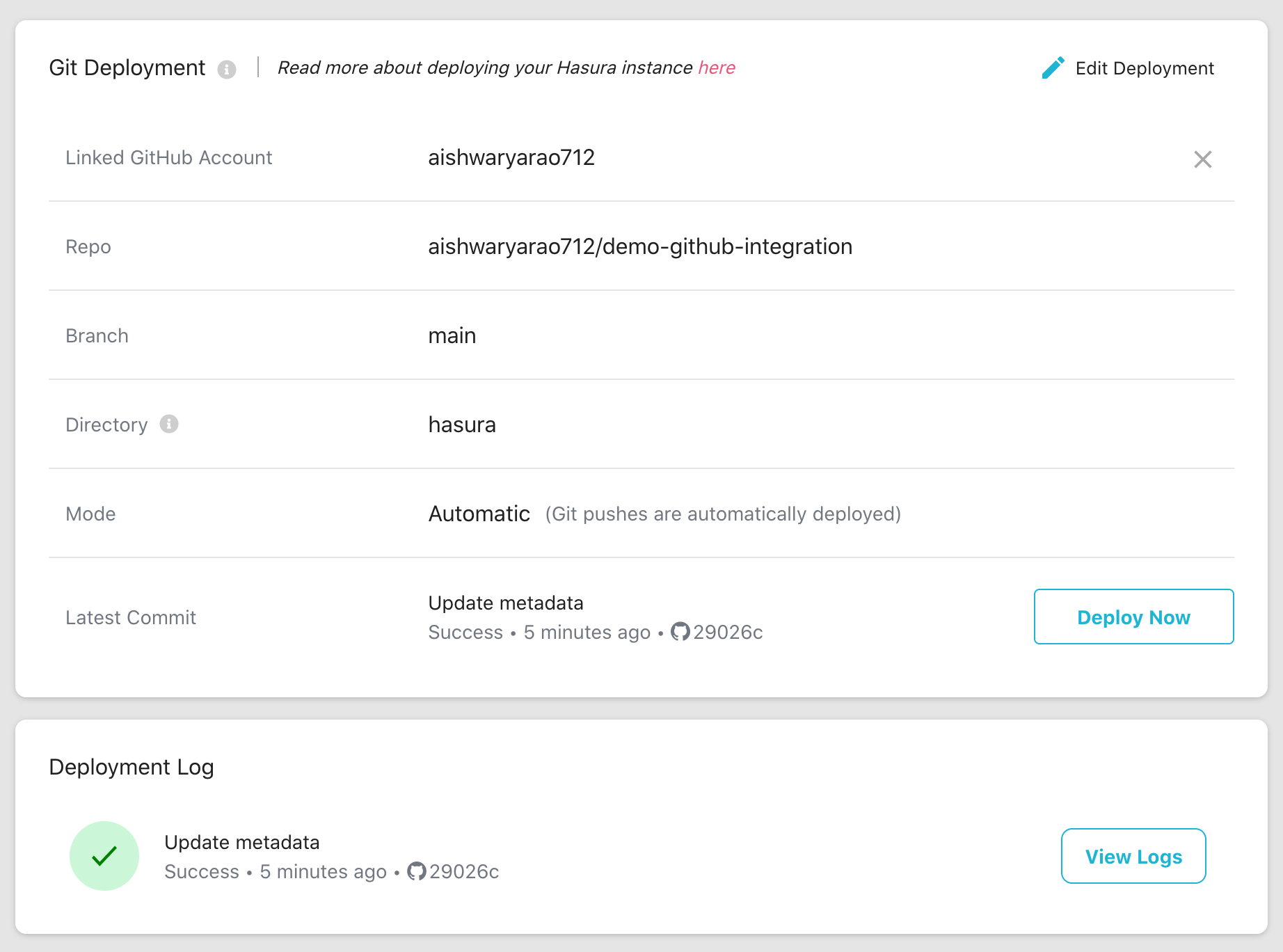
The Automatic deployment mode also has the Deploy Now button which allows the user to retry deploying the latest commit.
Manual Deployment Mode¶
With Manual deployment mode, Hasura Cloud does not automatically deploy the commits pushed to the configured branch.
The deployment of the latest commit in that branch can be triggered manually by clicking the Deploy Now button.

Initial setup¶
Link GitHub account to a Hasura Cloud project¶
To link a GitHub account, click on the Sign in with GitHub button in the Git Deployment section of the project details.
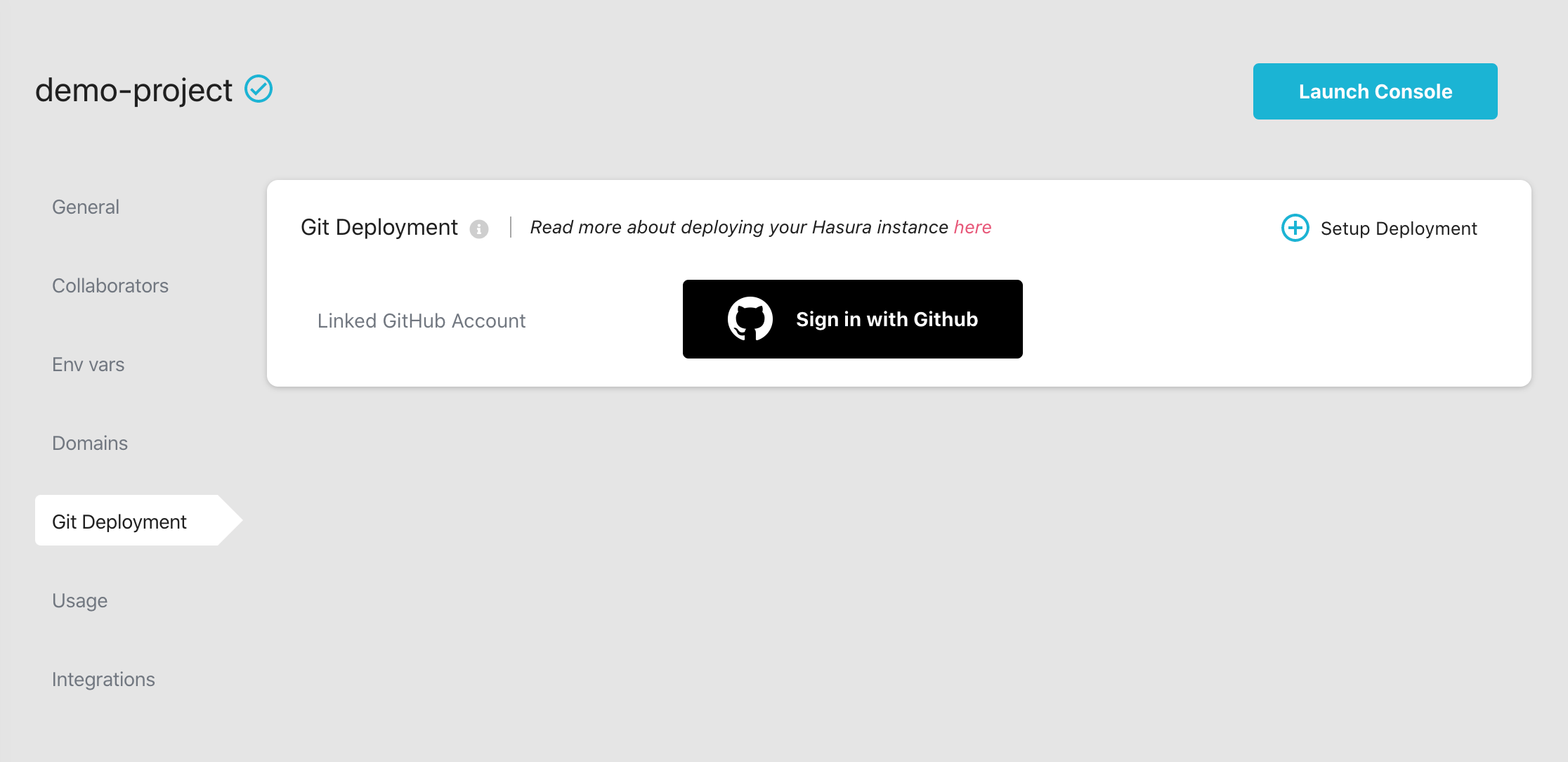
When you link a new GitHub account, Hasura Cloud installs the Hasura Cloud GitHub App on your GitHub account. While authenticating, you can choose to grant access to all repositories or to specific repositories only.

The permissions requested by Hasura Cloud can be viewed in the GitHub app settings once you install the app.
Once linked, the GitHub account with the granted scope becomes available to all the admins on the project as the session is used to manage the GitHub integration from the UI.
Integrate GitHub repo with a Hasura Cloud project¶
Specify the GitHub repository, branch and the hasura-project directory in the form as shown below.
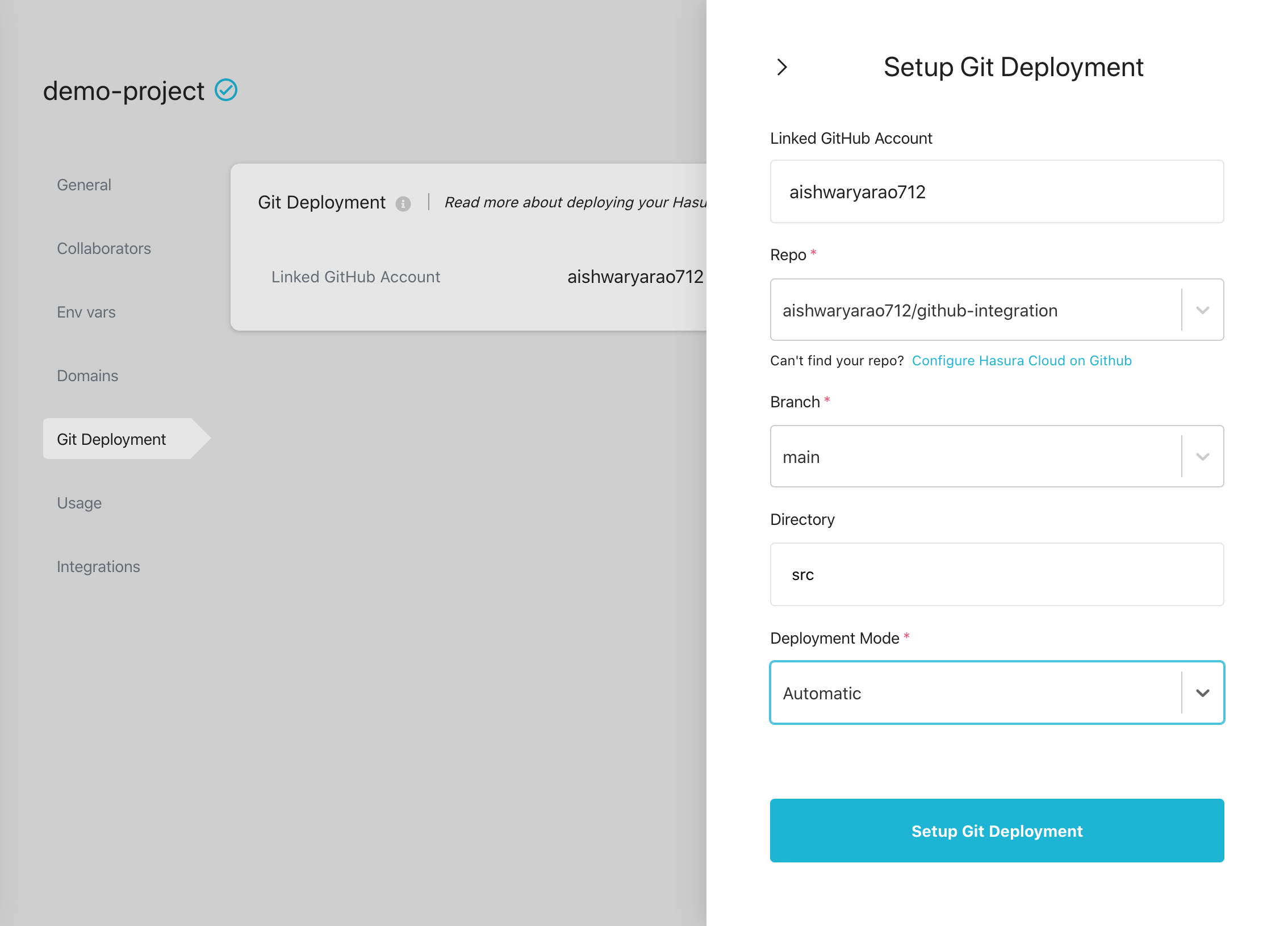
If the repository that you’re looking for doesn’t show up in the repository list, click Configure Hasura Cloud on GitHub
to grant access to the required repository.
Clicking on the Setup Git Deployment button integrates the specified GitHub repository, branch and directory with the
Hasura Cloud project. The details for the integration can be viewed in the Git Deployment section of project details.
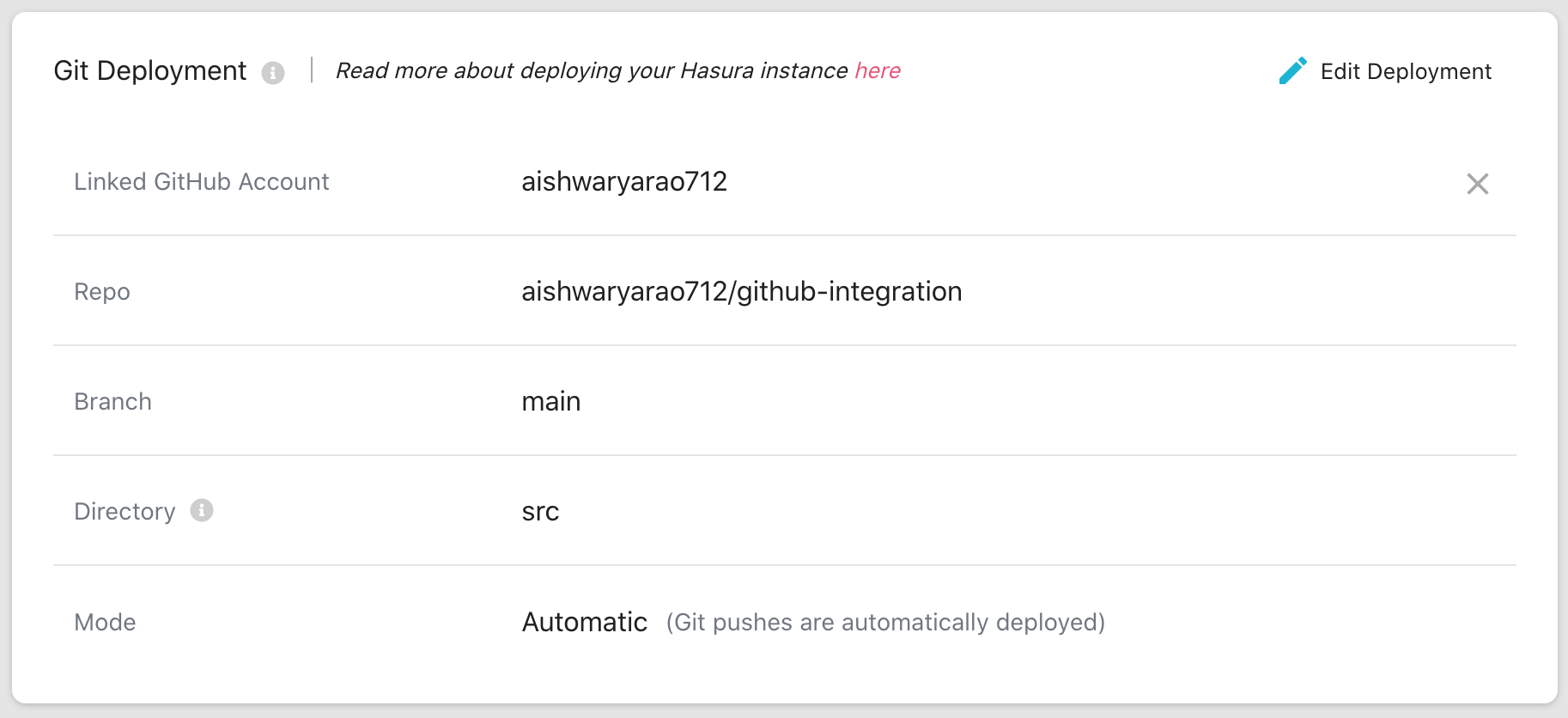
Edit GitHub Integration¶
Click on the Edit Deployment button in the GitHub Deployment section to edit the GitHub repository/branch/directory/deployment
mode for the GitHub integration.

Deployment Log¶
User can view the deployed commits and their deployment status in the Deployment Log section of Git Deployment.
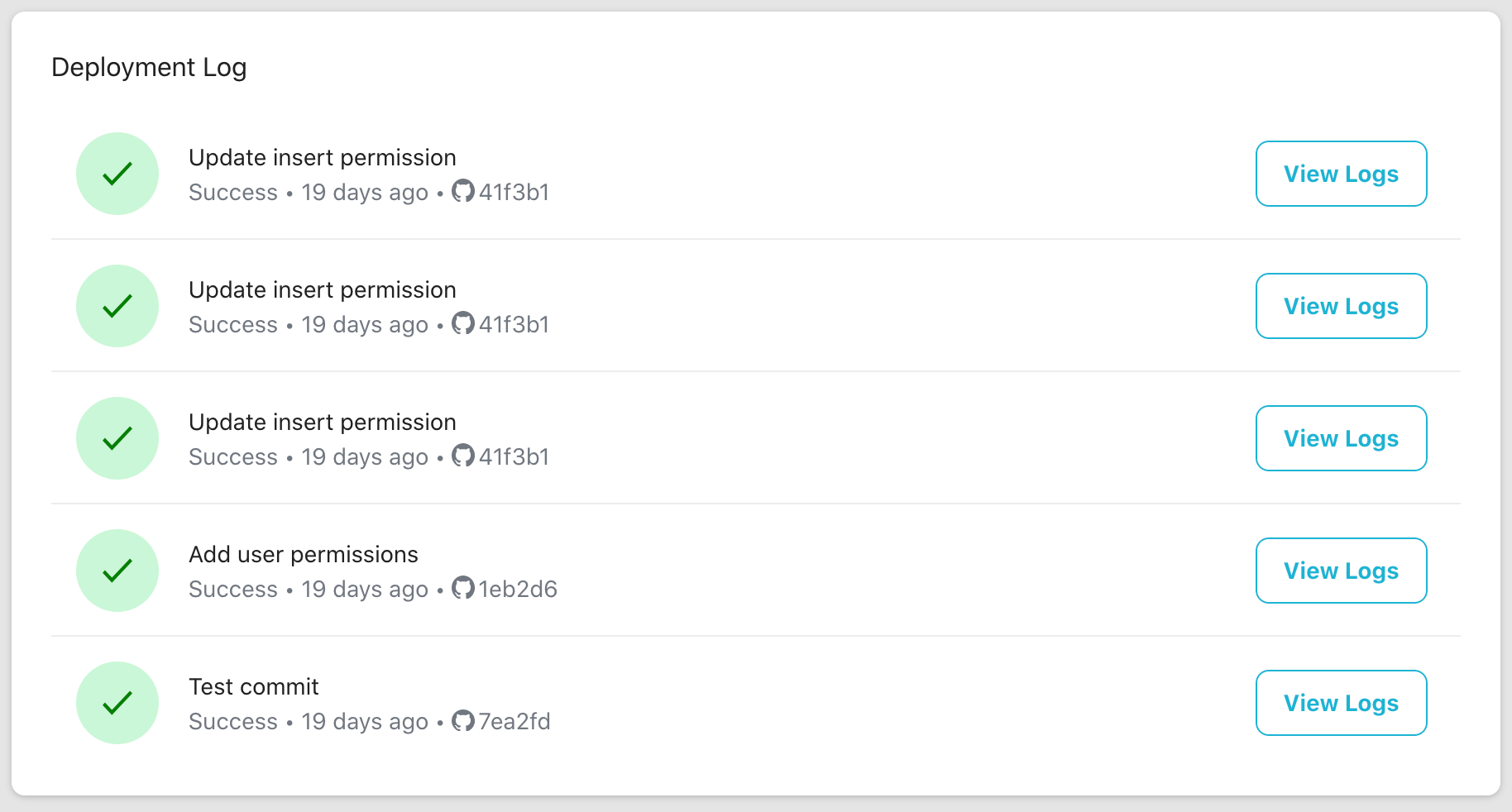
Deployment Process¶
Once a commit deployment is triggered, the progress for a commit can be tracked by clicking on the View Logs
button in the Deployment Log section.
Refer to the following task wise breakdown of the deployment job to understand what the job will be doing.
Check the troubleshooting section below and do reach out to support if you observe any issues with the deployment process or run into any other problems post the deployment.
Deployment sub-tasks¶
The following is a task wise breakdown of the commit deployment job.
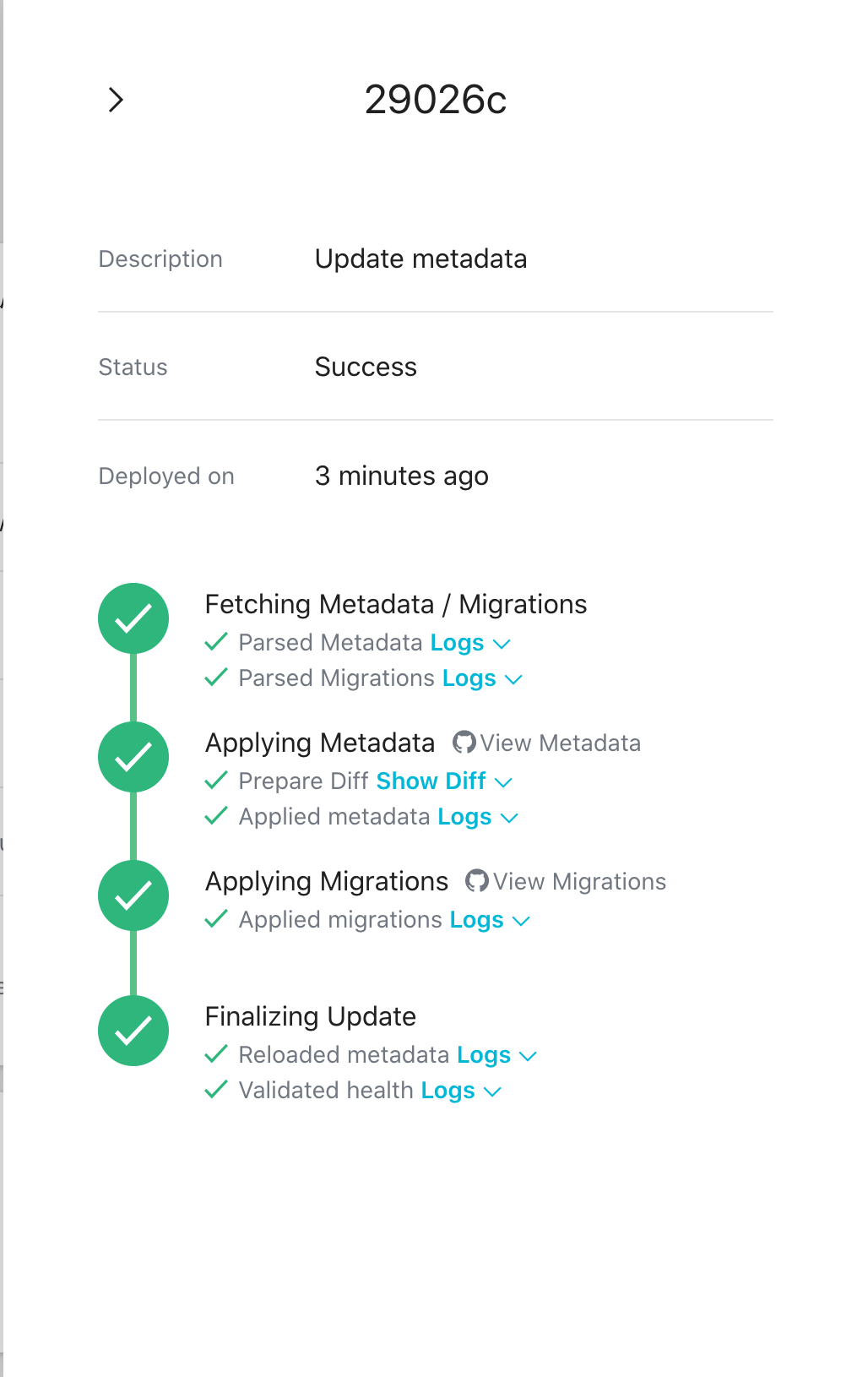
Each task in the deployment has realtime logs and can be viewed by clicking on the Logs option for each
successful/failed step.
Step 1: Fetching Metadata / Migrations¶
The metadata and migrations are fetched from the GitHub repository and validated.
Step 2: Applying Metadata¶
The metadata in the GitHub repository is applied to the server.
Step 3: Applying Migrations¶
The migrations in the GitHub repository are applied to your data sources.
Step 4: Finalizing Update¶
The metadata on the server is reloaded and project health is verified before finalizing the update.
Things to check before running your first deployment¶
You need to ensure the your Cloud project has been appropriately set up to execute the deployment.
- Ensure all the required Hasura config related and any other custom ENV vars that might be used in the metadata are added to your Cloud project as well.
- Ensure that you have connected the required database(s) with the right name and connection params as you have in the metadata to the Cloud project.
Troubleshooting Failures¶
If a deployment fails, depending on the kind of error, you can fix it by retrying the deployment by either updating your metadata and migrations with a fix and pushing a commit to deploy again or by just redeploying the failed commit after making any required fixes to your project.
The following are some troubleshooting steps to fix some possible errors in the deployment sub-tasks:
Error parsing metadata¶
- Nothing has been modified on your project yet so there will be no service impact.
- Typically happens due to some issue with the metadata directory structure or the format of the metadata files.
- Check the reported error message and fix the issues in the metadata. See metadata format.
- Push the fix to GitHub to redeploy.
Error parsing migrations¶
- Nothing has been modified on your project yet so there will be no service impact.
- Typically happens due to some issue with the migration directory structure or the format of the migration files.
- Check the reported error message and fix the issues in the migrations. See migrations format.
- Push the fix to GitHub to redeploy.
Error applying metadata¶
- Nothing has been modified on your project yet so there will be no service impact.
- Typically happens due to some invalid metadata (e.g. due to type mismatches, missing required keys, etc.) trying to be applied.
- Check the reported error message and fix the issues in the metadata. See metadata format.
- Push the fix to GitHub to redeploy.
Error applying migrations¶
As your metadata has already been applied but applying your migrations has failed, your project might be in an unhealthy state. If your migrations and metadata had only incremental changes, i.e. no existing objects were modified, you likely won’t have any service impact because existing parts of your metadata are likely to be still valid and your existing functionality will be working as it were.
Look at the underlying database error. Make the appropriate fix depending on the error and redeploy.
Some common errors:
source with name “default” is inconsistent
In this situation, most likely either the target project doesn’t have the required database connected or the ENV VARS or the database name used to connect the database is not matching in your source and target projects.
To fix this, use the same ENV VARS and connect the database with the same name in both your projects.
“relation “<some-object>” already exists”
In such situations when you get errors of tables or other objects already existing, this might be because the migration might have been already applied on the database and the project was not yet aware of it.
To fix this, use the Hasura CLI command
hasura migrate apply --skip-execution --version <migration_version> --endpoint "<cloud_project_endpoint>"to mark the migration as already applied on the project. Then redeploy the failed commit to continue with further steps.
Inconsistent metadata after finalizing update¶
- It is possible your project might be in an unhealthy state depending on which metadata objects are inconsistent and what migrations were applied. If your metadata and migrations had only incremental changes, i.e. no existing objects were modified, you likely won’t have any service impact because existing parts of your metadata are likely to be still valid and your existing functionality will be working as it were.
- Check the logs under
Applying MigrationsandFinalizing Update. - In the situation that the applied metadata applied was indeed incorrect, fix the metadata and push a new commit to redeploy.
- If objects depending on upstream services are inconsistent, e.g. remote schemas, the upstream service might be unavailable or inconsistent. In this case please fix them and redeploy the commit.
- If database objects are inconsistent with errors such as Inconsistent object: no such table/view exists in source: “<table-name>“,
it could be because:
- a migration might have been skipped as the project believes its already been applied though its not the case. To fix it, mark the migration as unapplied using the following
Hasura CLI command
hasura migrate delete --version <migration_version> --server --database-name <database-name> --endpoint <cloud_project_endpoint>and redeploy the commit. - a migration to create the database objects might be missing completely. To fix this create a new migration for creation of the missing objects and push a new commit to redeploy.
- a migration might have been skipped as the project believes its already been applied though its not the case. To fix it, mark the migration as unapplied using the following
Hasura CLI command
- A rollback can be done to the previous functioning state of metadata by reverting your metadata changes on your branch and then pushing to redeploy.
